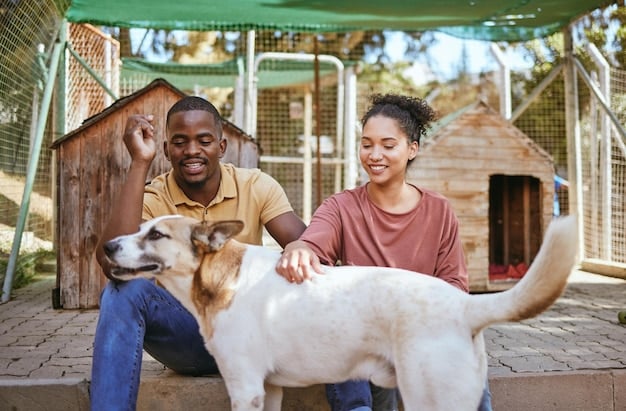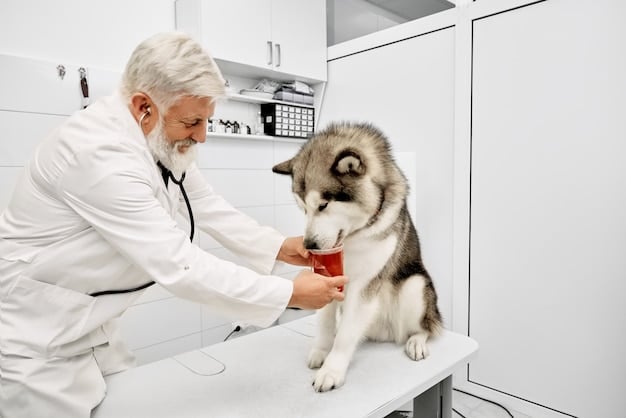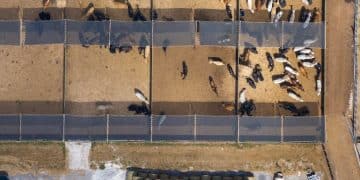Effective Animal Handling: Stress Reduction & Safety in Rescues

Effective animal handling techniques at local animal rescues prioritize minimizing stress and maximizing safety for both animals and handlers through understanding animal behavior, using appropriate restraint methods, and creating a calm environment.
Navigating the delicate world of animal rescue requires more than just compassion; it demands effective animal handling techniques. These techniques are crucial for reducing stress, ensuring the safety of both the animals and the handlers, and fostering a positive environment within your local animal rescue.
Understanding Animal Behavior in Rescue Settings
Before implementing any handling technique, it’s essential to understand the unique behavioral challenges animals face in rescue settings. These animals often come from traumatic backgrounds and may exhibit fear, aggression, or anxiety. Recognizing these behaviors is the first step in providing appropriate care.
Common Behavioral Issues in Rescue Animals
Many rescue animals display a range of behavioral issues stemming from past experiences. Identifying these issues early is key to tailoring your handling approach.
- Fearfulness: Animals may cower, tremble, or attempt to escape when approached.
- Aggression: This can manifest as growling, snapping, or biting, often out of fear or defensiveness.
- Anxiety: Signs include excessive panting, pacing, and destructive behavior.
- Withdrawal: Some animals may become unresponsive or avoid interaction altogether.
The Importance of Recognizing Stress Signals
Understanding an animal’s stress signals can prevent escalation of fear or aggression. Subtle cues such as whale eye (showing the whites of their eyes), lip licking, yawning, or a tucked tail can indicate discomfort or anxiety. Responding to these signals promptly can prevent more serious behavioral responses.
By understanding these common behavioral issues and recognizing stress signals, handlers can approach animals with greater empathy and adapt their techniques to minimize stress and promote a sense of safety.
Creating a Safe and Calm Environment
A calm and safe environment is paramount for minimizing stress during animal handling. This involves careful consideration of the physical space, noise levels, and overall atmosphere of the rescue facility. A well-managed environment can significantly improve an animal’s well-being and cooperation.

Optimizing the Physical Space
Consider the layout and design of the rescue to promote calmness. Separate animals based on their individual needs and temperaments to reduce stress. Provide ample space for movement and retreat.
- Designated Quiet Zones: Create areas where animals can retreat from noise and activity.
- Secure Enclosures: Ensure enclosures are escape-proof and provide a sense of security.
- Comfortable Bedding: Soft bedding can contribute to a sense of comfort and security.
Managing Noise and Stimulation
Reducing noise and excessive stimulation is crucial. Loud noises and chaotic environments can exacerbate anxiety and fear. Employ sound-dampening materials where possible and maintain a consistent routine to provide predictability.
By carefully managing the physical space and controlling noise and stimulation, rescue facilities can create an environment that significantly reduces stress and promotes a sense of security for the animals in their care.
Essential Tools and Equipment for Safe Handling
Having access to the right tools and equipment is essential for safe and effective animal handling. These tools not only protect the handler but also ensure the animal’s safety and comfort during necessary procedures. The selection of equipment should be tailored to the specific needs of the animals in the rescue.
Leashes, Harnesses, and Carriers
Leashes and harnesses provide control during walks and transport, while carriers offer a secure space for moving animals. Selecting the right size and type is critical for comfort and safety.
- Appropriate Leash Length: Use a leash that allows sufficient control without restricting movement.
- Well-Fitting Harness: A properly fitted harness distributes pressure evenly and prevents escape.
- Secure Carriers: Ensure carriers are well-ventilated and appropriately sized for the animal.
Protective Gear for Handlers
Protective gear such as gloves and bite sleeves are essential for handlers, especially when working with animals that may be fearful or aggressive. This equipment provides a barrier against potential injuries.
Equipping handlers with the correct tools and protective gear ensures that animal handling is conducted safely and effectively, minimizing the risk of injury for both the animal and the handler.

Positive Reinforcement Techniques
Positive reinforcement is a highly effective approach to animal handling that focuses on rewarding desired behaviors rather than punishing undesired ones. This method builds trust, reduces stress, and encourages cooperation. Utilizing treats, praise, and gentle touch, handlers can create positive associations with handling procedures.
Using Treats and Praise
Treats and verbal praise are powerful motivators. When an animal exhibits a desired behavior, such as remaining calm during a medical examination, immediately reward them with a treat and positive verbal reinforcement.
Clicker Training Basics
Clicker training is a specific form of positive reinforcement that uses a clicker to mark the exact moment an animal performs the desired behavior. The clicker sound becomes associated with a reward, making it easier to communicate with the animal.
By employing positive reinforcement techniques, handlers can foster a cooperative relationship with rescue animals, making handling procedures less stressful and more effective.
Handling Different Species
Rescue facilities often care for a variety of animal species, each with its unique handling requirements. Understanding these species-specific needs is crucial for ensuring their safety and well-being during handling procedures. Different species require tailored approaches based on their physical characteristics, behaviors, and sensitivities.
Dog Handling Techniques
Dogs vary widely in size, temperament, and breed characteristics, requiring a flexible approach to handling. Start with a slow, gentle approach, allowing the dog to approach you first. Use positive reinforcement and avoid sudden movements or loud noises.
Cat Handling Techniques
Cats can be particularly sensitive to stress, making gentle and calm handling essential. Support their body weight properly and avoid restraining them tightly. Use a soft voice and approach them slowly.
Small Mammal Handling Techniques
Small mammals like rabbits and guinea pigs require careful handling to avoid injury. Always support their body weight and avoid squeezing them tightly. Be mindful of their fragile bones and sensitive nature.
Adapting handling techniques to the specific needs of each species is crucial for ensuring the safety and well-being of all animals in the rescue’s care.
Training and Education for Staff and Volunteers
Comprehensive training and education are essential for ensuring that all staff and volunteers are equipped with the knowledge and skills necessary for effective animal handling. Training should cover a range of topics, including animal behavior, safe handling techniques, stress reduction strategies, and species-specific considerations. Regular refresher courses and ongoing education can help maintain a high standard of care within the rescue facility.
Basic Animal Behavior Training
A foundational understanding of animal behavior is crucial for recognizing signs of stress, fear, and aggression. This knowledge enables handlers to respond appropriately and prevent potential incidents.
Hands-On Handling Workshops
Practical workshops provide staff and volunteers with the opportunity to practice handling techniques under the guidance of experienced professionals. These workshops should cover a variety of scenarios and species.
- Demonstrations: Visual demonstrations of proper handling techniques.
- Practice Sessions: Supervised practice with different animal species.
- Role-Playing: Simulating common handling scenarios to build confidence.
Certification Programs
Certification programs offer a more structured and comprehensive approach to training. These programs often include written exams, practical assessments, and continuing education requirements.
Investing in comprehensive training and education for staff and volunteers ensures that all animals receive the highest standard of care and that handling procedures are conducted safely and effectively.
| Key Point | Brief Description |
|---|---|
| 🐾 Understanding Animal Behavior | Recognizing signs of stress and fear to tailor handling. |
| 🛡️ Safe Environment | Creating a calm space reduces anxiety during handling. |
| 🦴 Positive Reinforcement | Using treats and praise to encourage desired behaviors. |
| 👩⚕️ Training & Education | Equipping staff with the knowledge for safe handling. |
Frequently Asked Questions
▼
Effective animal handling minimizes stress for animals, ensures handler safety, and promotes a positive environment, aiding rehabilitation and adoption processes in rescues.
▼
Signs of stress include panting, trembling, flattened ears, whale eye (showing whites of eyes), lip licking, or attempts to escape during the handling process.
▼
Positive reinforcement builds trust and encourages cooperation by rewarding desired behaviors with treats, praise, or affection leading to less stressful interactions.
▼
Essential tools include appropriate leashes, well-fitting harnesses, secure carriers, and protective gear like gloves to ensure both animal and handler’s safety.
▼
Training equips staff with the knowledge and skills for safe and effective animal handling, improving welfare and preventing accidents and injuries in the workplace.
Conclusion
In conclusion, mastering effective animal handling techniques is paramount for local animal rescues aiming to create a safe and nurturing environment. Through understanding animal behavior, utilizing positive reinforcement, and providing thorough training, rescues can significantly reduce stress and improve the overall well-being of the animals in their care, facilitating successful rehabilitation and adoption outcomes.





